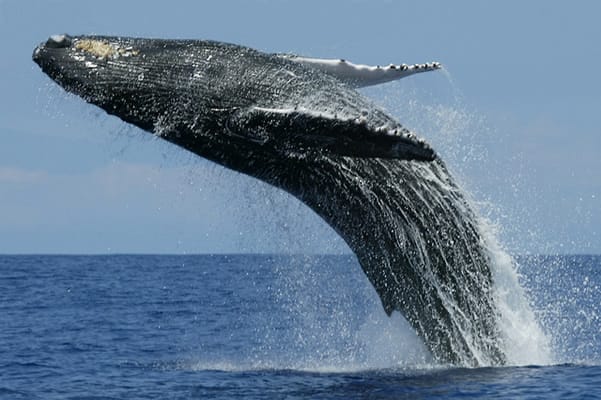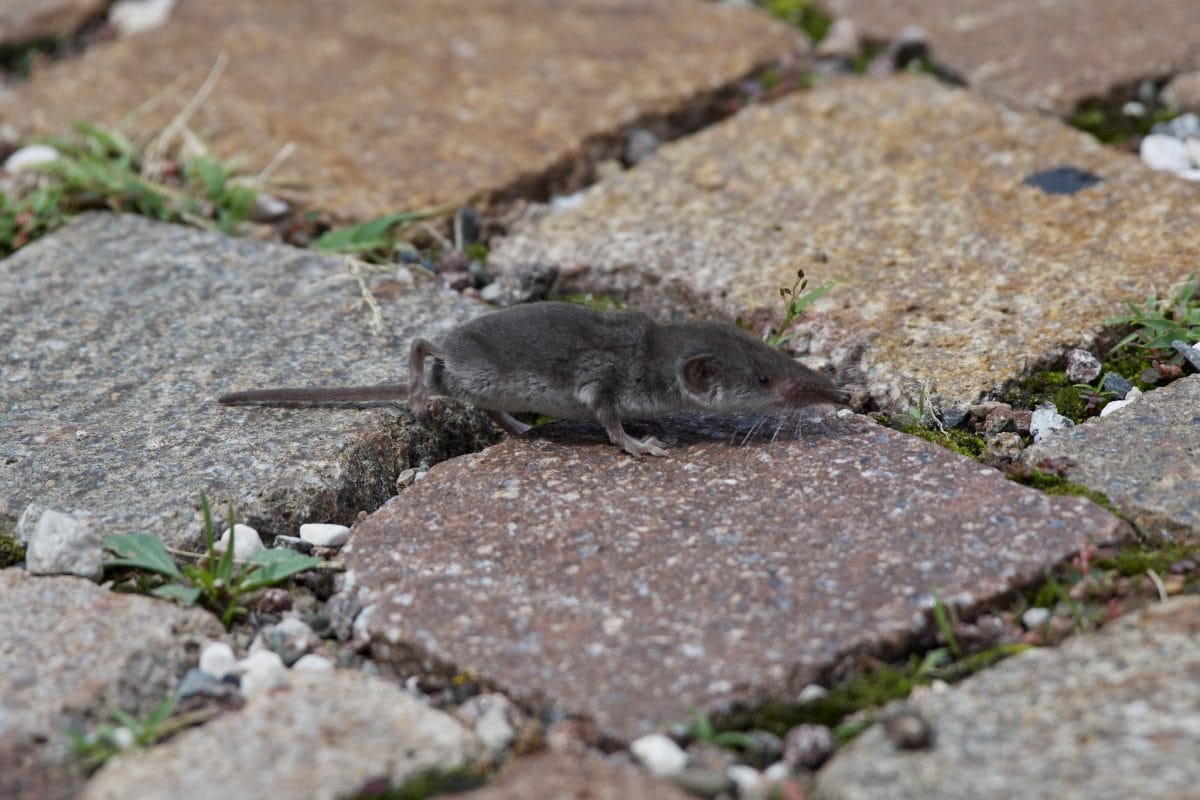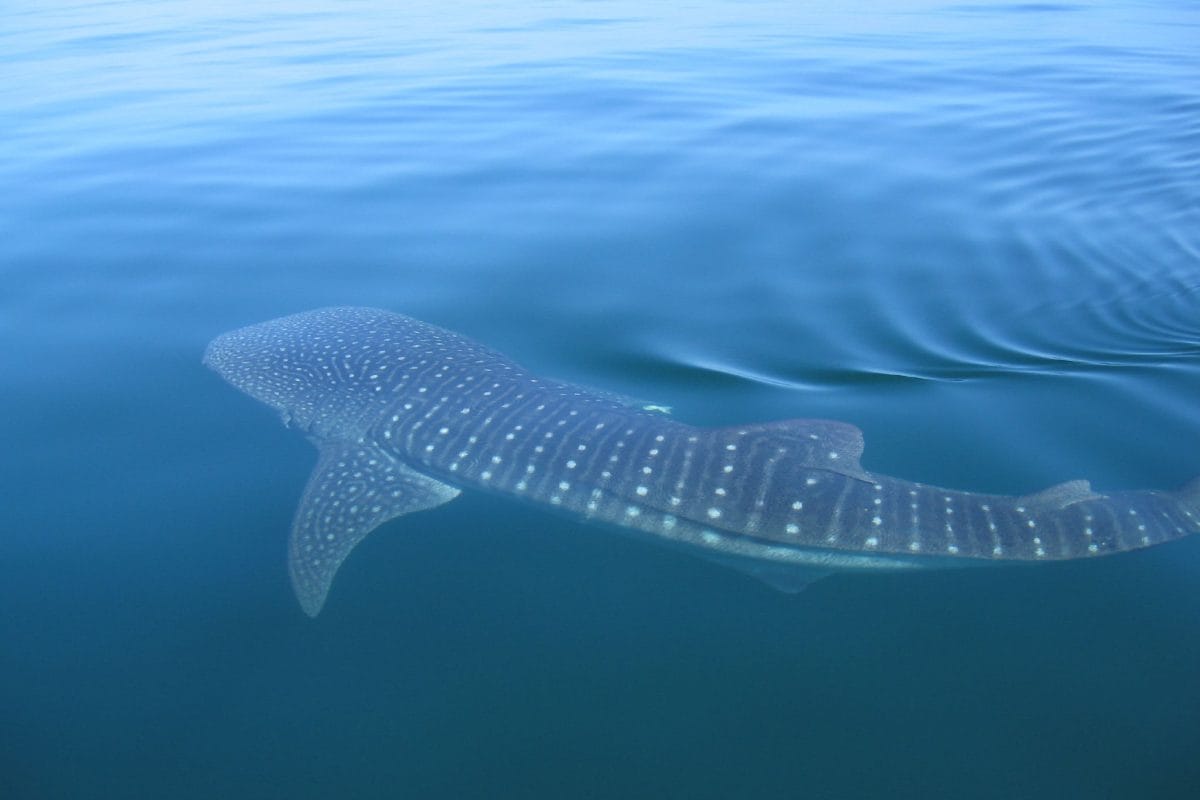Explore the biggest and smallest animals in the world, learning about how they live and some of their characteristics in this blog.
Mammals
What is the biggest mammal? The blue whale.
The blue whale is the world’s largest mammal, once considered to be the biggest animal ever to have lived on Earth.
These enormous creatures reach maximum lengths of around 30 metres, around the size of two double-decker buses end-to-end. They weigh the same as approximately 33 elephants and their hearts can grow to the size of a small car.
Not only are these animals ginormous, they are also noisy! Blue whales can emit calls that travel farther than any other voice in the animal kingdom. Their vocalisations can reach 180 decibels, which is as loud as a jet engine. It is thought these enormous animals can hold their breath for up to 90 minutes at a time, though they are usually fairly shallow divers to depths of 100-200 metres. Unlike humans, blue whales take a series of short naps, around 30 minutes long, rather than sleeping through the night. This is because they have to sleep near the surface in order to keep breathing and so their body temperature doesn’t drop too low from not moving.
Blue whales are found in all oceans except the Arctic. Generally, they are more common in the Southern Hemisphere. They usually live alone or in pairs, occasionally travelling the waters in small groups. During the summer months, blue whales dwell in polar waters and feed on krill. It is estimated that blue whales eat up to eight tons of krill each day. During winter, they migrate closer to the Equator to breed.
The average lifespan of a blue whale is around 80-90 years. Unfortunately, the global population of blue whales is currently critically endangered due to commercial whaling and illegal hunting.

What is the smallest mammal? The Etruscan shrew.
The Etruscan shrew is the world’s smallest mammal by weight alive today. These tiny creatures can weigh as little as 1.5 grams and grow to between 36-52 millimetres long. The Etruscan shrew is a member of the insect-eating shrew family and is fairly similar to a mole.
Etruscan shrews are found in southern Europe and from North Africa up to Malaysia. They live in warm, damp forests and grasslands. They are thought to have a lifespan stretching around two years and are as yet not at great threat from the climate emergency.
The Etruscan shrew lives off a diet of insects, although occasionally it feeds on some worms and small lizards. They eat twice their own body weight a day.

Fish
What is the largest fish? A whale shark.
Despite its name, a whale shark is not actually a whale but a fish. These gentle giants live in tropical waters and grow up to 12 metres long, which is roughly the same length as a large shipping container.
Whale sharks are filter feeders and they can neither bite nor chew, although their mouths can stretch to four feet wide. Despite this, they wouldn’t be able to swallow a human because a whale shark’s oesophagus is only as wide as a human fist. Their diet is made up of plankton, small crustaceans and schooling fish.
These giant fish migrate thousands of miles to different feeding grounds throughout their lifetimes, but they swim very slowly, at around 3mph. Because whale sharks need to be moving through water in order to filter oxygen to breathe, sleep is impossible. Instead, they rest by swimming very slowly while turning off parts of their brain to conserve energy.
Whale sharks are under threat from plastic pollution, commercial fishing, waters warming due to the climate emergency and hunting – their fins are considered a culinary delicacy in Asia. It is thought that only around 10% of whale sharks born survive to adulthood, but those that do can live up to 150 years. At the moment, whale shark numbers are thought to be dropping at a rate unprecedented in the history of the planet, with the possible exception of the K-T mass extinction which wiped out the dinosaurs.
Conservation projects are racing to find more out about whale sharks before their numbers drop too low. There is still so much researchers don’t know about the species, including many of their reproduction behaviours, which complicates conservation efforts.

What is the smallest fish? The photocorynus spiniceps.
The smallest fish in the world is a species of angler fish called photocorynus spiniceps. The male fish of the species measure only between 6.2-7.3 millimetres and are the smallest known vertebrate in the animal kingdom.
These fish live at depths of 990-1420 metres in tropical and sub-tropical waters in the Western Atlantic and Pacific Ocean.
Female photocorynus spiniceps fish are much larger, so the male fish spends much of its life fused to the female’s body, leeching from her resources. The male fish’s role extends only to aiding reproduction by using its testes, which are enormous in relation to its body size.
These fish eat other fish and invertebrates. They hunt by wiggling a fleshy, bioluminescent growth on their head to attract prey. The bioluminescence is caused by a collection of glowing bacteria that gather inside the fleshy knobble. In this mutually beneficial exchange, the bacteria help anglerfish attract prey and the fish protects the bacteria and allows it to gather nutrients as it swims along.

Reptiles
What is the largest reptile? The saltwater crocodile.
Saltwater crocodiles can reach up to six and a half metres long and weigh up to one tonne. Not only are they huge, but they also have the strongest bite in the animal kingdom and their teeth can measure up to 13 centimetres long.
These mighty reptiles live in warm or tropical climates stretching from the eastern Indian and western Pacific oceans. They prefer mangrove forests and other coastal habitats. Although saltwater crocodiles are solitary, they communicate using several sounds, including barking, hissing, chirping and growling.
Saltwater crocodiles prefer to hunt at night and their diet consists of fish, mammals and birds. They take in most of their liquids from their prey too, instead of regularly drinking. They can hold their breath for long periods of time, which allows them to lurk in the shallows along the water’s edge and wait for land mammals to approach, at which point the crocodile will attack in a violent lunge.
These crocodiles guard their territory ferociously and have been roaming the Earth since before the dinosaurs went extinct. The earliest evidence of crocodilian creatures comes from 95 million years ago, in the Late Cretaceous period.

What is the smallest reptile? The brookesia nana.
The smallest reptile in the world is a type of chameleon called a brookesia nana, which is the same size as a sunflower seed. They exist on a diet of mites and springtails but, unlike many other types of chameleon, the brown-hued brookesia nana cannot change colour. These tiny creatures were only discovered in 2021 and so far, only two specimens of this chameleon have ever been seen, one male and one female. Because we’re still finding new species, it’s important to preserve diverse habitats as much as possible.
The brookesia nana is native to Madagascar in the Indian Ocean and was found in a degraded rainforest. While this micro-chameleon is the smallest ever found, there are lots of tiny chameleon species in the northern forests of Madagascar.
Nano chameleons are the product of an evolutionary process called miniaturisation. This process is fairly common on islands as species respond to their environments – smaller bodies mean lower calorific needs and a better chance of hiding from predators.
Birds
What is the biggest bird? A common ostrich.
The common ostrich is the largest bird in the world and can stand at heights of up to 2.8 metres. Although these enormous animals can weigh as much as a piano, they remain agile and are the fastest living land birds, with running speeds reaching 40mph.
Ostriches live in grasslands, savannahs and open woodlands. They are native to Africa but have been introduced and live wildly in Australia. They lay enormous eggs, the largest of any bird and their diet is mainly herbivorous, mainly made up of shrubs, grass, flowers and seeds. Ostriches are flightless birds, but their wings still come in handy. They use them in displays of courtship and to provide balance while running.
The height of an ostrich and their sharp eyesight allows them to spot predators from great distances. They can hide from predators by lying low among tall grasses and stretching their neck along the ground. But if an ostrich feels threatened, it can be a very dangerous creature. Ostriches can cover 5 metres in a single stride and the claws on their feet can grow to 10cm long. Their powerful kicks can strike and kill predators including lions, hyenas, cheetahs and leopards. They could even kill a human.

What is the smallest bird? A bee hummingbird.
The bee hummingbird is the smallest bird known to man. This species is so small that the birds are often mistaken for bees, hence the name. They weigh less than two grams and eggs laid by the females are the size of a coffee bean.
Although small – bee hummingbirds usually measure around 5.5cm – these birds are mighty. During flight, their wings beat up to 80 times per second. Bee hummingbirds move their wings in a figure-of-eight pattern, which gives them the ability to fly swiftly and hover with impressive agility. They can reach top speeds of 30mph and they can fly for up to twenty hours without a break.
Bee hummingbirds are solitary creatures and live in the forests, swamps and mountains of Cuba. Because they are native only to such a localised area it’s important to maintain these diverse habitats so we don’t lose species. They feed on woodland flowers and have evolved a slender beak and long tongue to sip nectar from flowers. In a single day, a bee hummingbird can pollinate up to 1,500 flowers.
Unfortunately, bee hummingbirds are in rapid decline due to habitat loss. They are preyed on by larger birds including hawks and kestrels, as well as frogs, fish and tropical spiders. Their conservation status is near threatened and could continue to decline without intervention.

Dinosaurs
What was the largest dinosaur? The patagotitan mayorum.
The patagotitan mayorum is the largest dinosaur that ever lived… that we know of! It walked the Earth between 100-95 million years ago, during the Late Cretaceous period, in what is now Patagonia, Argentina. Like a diplodocus, the patagotitan mayorum was a plant-eating dinosaur equipped with a long neck to better reach vegetation.
A cast made of a fossilised titanosaur’s skeleton measures 122 feet lengthways and is approximately 28 feet tall, meaning in life the patagotitan mayorum would have been bigger than a blue whale. It would have weighed around 70 tons, or the same as ten African elephants. Scientists believe its footsteps would have shaken the ground as it wandered. Inconceivably, it is thought a dinosaur of this size hatched from a football-sized egg, though at full size it is considered to be close to the maximal limit for terrestrial animals.
The existence of this giant herbivore was discovered when an Argentine rancher stumbled upon an enormous bone in desert terrain. An excavation got underway and, in 2017, the titanosaur was named and described as a new species.

What was the smallest dinosaur? A microraptor.
The microraptor is thought to be the smallest dinosaur as yet discovered. At only a foot tall, it is considered close in size to a modern crow. Microraptors were carnivorous dinosaurs thought to have lived around 125 million years ago. Fossils have been discovered in what is now northeastern China.
The microraptor had flight feathers growing from its front and back limbs, although it was thought to glide in the air to catch prey such as insects, rather than fly. In this way it could be compared to a flying squirrel, rather than a bird. But unlike a squirrel, scientists have discovered the microraptor’s feathers were iridescent, giving the dinosaur a metallic shine similar to those seen on peacocks and hummingbirds. These discoveries have been made by studying fossilised feather impressions in rocks.
In 2020, scientists thought they had discovered a dinosaur even smaller than the microraptor. They named this creature the oculudentavis, or eye-tooth-bird, because of its unusually large eyes and numerous teeth. The oculudentavis was as small as a bee hummingbird, only half an inch in length. But this discovery was later retracted when the eye-tooth-bird was reclassified as an unusual prehistoric lizard, rather than a dinosaur.



